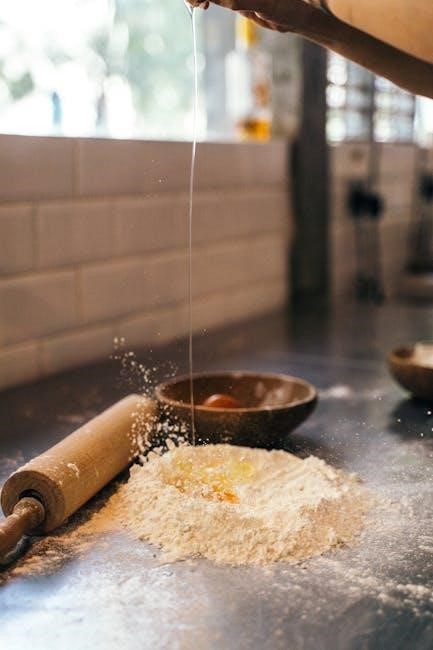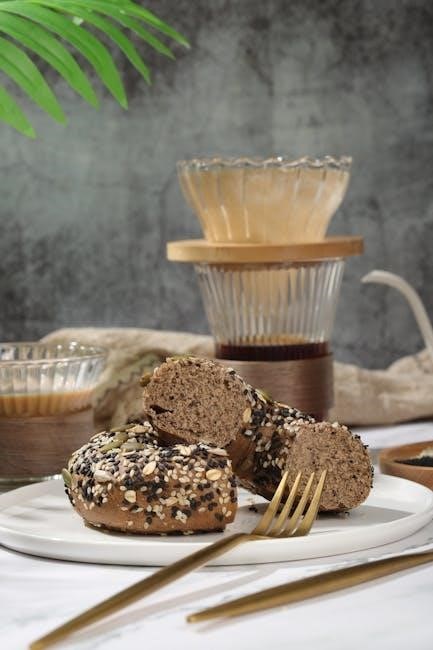Here’s the requested content:

Panasonic Bread Maker Recipes: A Comprehensive Guide
Unlock a world of baking possibilities with your Panasonic bread maker! This guide is your gateway to an array of delectable recipes, including how to access free recipe PDFs, ensuring you bake the perfect loaf every time․ Explore the joy of homemade bread today!
Panasonic bread makers have earned a reputation for reliability and ease of use, becoming a staple in many kitchens for fresh, homemade bread․ These machines simplify the baking process, automating kneading, rising, and baking․ With a Panasonic bread maker, creating various types of bread, from basic white to complex whole wheat and even gluten-free options, becomes incredibly accessible․
The appeal of these bread makers lies in their convenience․ Instead of spending hours manually kneading dough and monitoring the oven, users can simply add ingredients, select a program, and let the machine do the rest․ Many models come with pre-programmed settings for different types of bread, doughs, and even cakes, taking the guesswork out of baking․
Moreover, Panasonic bread makers often include features like a fruit and nut dispenser, allowing for the automatic addition of these ingredients at the optimal time․ This ensures even distribution throughout the loaf, enhancing the flavor and texture․
Beyond convenience, these bread makers offer the satisfaction of enjoying freshly baked bread made with ingredients you control․ This is particularly beneficial for those with dietary restrictions or preferences, as they can tailor recipes to suit their needs․ Whether you’re a seasoned baker or a novice, a Panasonic bread maker can open up a world of delicious possibilities․
Okay, here’s the content for the “Finding Free Recipe PDFs” subheading, adhering to all specified requirements:
Finding Free Recipe PDFs
Discovering a wealth of bread-making inspiration for your Panasonic bread maker is easier than you might think! Numerous online resources offer free recipe PDFs specifically tailored for these machines․ A great starting point is the official Panasonic website, which often provides downloadable manuals and recipe booklets for various models․
Beyond the official source, explore online communities and forums dedicated to bread making․ These platforms frequently host user-submitted recipes, tips, and tricks, often shared in PDF format for easy access․ Websites specializing in recipe collections are another valuable resource․ Search for “Panasonic bread maker recipes PDF” to uncover a treasure trove of options․
Don’t overlook websites that archive user manuals and guides․ These sites sometimes feature older Panasonic bread maker manuals containing a variety of classic recipes․ Additionally, consider searching online libraries and document-sharing platforms․ Many users upload recipe collections and guides to these sites, making them readily available for download․
Remember to be cautious when downloading files from the internet․ Ensure that the source is reputable and that your antivirus software is up-to-date․ With a little searching, you’ll find an abundance of free recipe PDFs to expand your baking repertoire and create delicious bread with your Panasonic bread maker․
Okay, here is the text for the “Popular Panasonic Bread Maker Models” subheading:
Popular Panasonic Bread Maker Models
Panasonic has established itself as a leading brand in bread makers, offering a range of models catering to different needs and preferences․ Among the popular choices, the SD-YR2550 stands out with its versatile programs and automatic ingredient dispenser, simplifying the bread-making process․ Another well-regarded model is the SD-ZB2502, known for its reliable performance and comprehensive recipe selection․

The SD-2501 and SD-2500 series have also garnered significant popularity, offering a balance of features and affordability․ These models typically include various bread programs, crust control options, and a timer for delayed baking․ For those seeking a compact option, the SD-RD250 is a notable choice, providing a smaller footprint without compromising functionality․
When choosing a Panasonic bread maker, consider factors such as the size of loaves you typically bake, the range of programs offered, and any additional features like fruit and nut dispensers․ Reading reviews and comparing specifications can help you determine the best model for your needs․ Each model has its own unique strengths, ensuring there’s a Panasonic bread maker to suit every baker’s requirements․
Finding recipes tailored to your specific model is crucial for optimal results․ Many online resources and communities cater to particular Panasonic bread maker models, offering customized recipes and troubleshooting advice․
Here’s the requested text:
Basic White Bread Recipe
Mastering the basic white bread recipe is essential for any Panasonic bread maker enthusiast․ This foundational recipe serves as a building block for countless variations and provides a reliable starting point for beginners․ The key to a perfect loaf lies in precise measurements and the quality of ingredients;
For a standard 1․5-pound loaf, you’ll typically need around 3 cups of bread flour, 1․25 cups of water, 1․5 teaspoons of salt, 1․5 tablespoons of sugar, 1․5 tablespoons of vegetable oil, and 2․25 teaspoons of active dry yeast․ Always add the ingredients in the order recommended by your Panasonic bread maker manual, usually starting with liquids and ending with yeast․
Select the basic white bread program on your machine, choose your desired crust color, and press start․ The bread maker will handle the kneading, rising, and baking processes automatically․ Keep a close eye on the dough during the first kneading cycle; it should form a smooth, elastic ball․ If the dough seems too dry, add a tablespoon of water at a time․ If it’s too sticky, add a tablespoon of flour․
Once the baking cycle is complete, remove the bread pan and let it cool slightly before removing the loaf․ Enjoy your freshly baked white bread!
Here’s the requested text:
Whole Wheat Bread Recipe
Baking whole wheat bread in your Panasonic bread maker is a fantastic way to enjoy a healthier and more flavorful loaf․ This recipe utilizes the goodness of whole wheat flour, providing a boost of fiber and nutrients compared to white bread․ Achieving the right texture and rise with whole wheat requires some adjustments to the basic white bread recipe․
A typical whole wheat bread recipe for a 1․5-pound loaf includes around 3 cups of whole wheat flour, 1․25 cups of water, 2 tablespoons of honey or molasses, 1․5 teaspoons of salt, 2 tablespoons of olive oil, and 2․5 teaspoons of active dry yeast․ The addition of honey or molasses helps to enhance the flavor and provide extra food for the yeast, which can be slower to activate in whole wheat dough․
When using your Panasonic bread maker, select the whole wheat bread program․ Due to the denser nature of whole wheat flour, the kneading time may need to be slightly longer․ Observe the dough during the kneading process, adding a tablespoon of water at a time if it appears too dry․ The finished loaf should be slightly denser than white bread but still have a pleasant, chewy texture․
Enjoy your wholesome and delicious homemade whole wheat bread!
Here’s the requested text:
Gluten-Free Bread Recipes
Creating gluten-free bread in a Panasonic bread maker requires a different approach than traditional wheat-based bread․ Gluten, the protein found in wheat, provides structure and elasticity to dough․ Without it, gluten-free bread can be dense or crumbly․ However, with the right recipe and techniques, you can achieve delicious gluten-free loaves․
A typical gluten-free bread recipe utilizes a blend of gluten-free flours such as rice flour, tapioca starch, potato starch, and cornstarch․ Xanthan gum is a crucial ingredient, acting as a gluten substitute to bind the ingredients and provide structure․ A common recipe for a 1․5-pound loaf includes 1․5 cups of gluten-free flour blend, 1 cup of milk or non-dairy milk, 2 tablespoons of oil, 1 tablespoon of sugar, 1 teaspoon of salt, 2 teaspoons of xanthan gum, and 2 teaspoons of active dry yeast․
It’s essential to use the gluten-free setting on your Panasonic bread maker if available․ If not, a basic or rapid setting can be used, but monitor the dough closely․ Gluten-free doughs tend to be wetter than wheat-based doughs․ Avoid opening the bread maker during baking, as temperature fluctuations can affect the rise․ Let the bread cool completely before slicing to prevent it from crumbling․ Enjoy your freshly baked gluten-free bread!
Here’s the requested text:
Specialty Bread Recipes (e․g․, Easter Bread)

Elevate your bread-making game with specialty recipes tailored for your Panasonic bread maker․ These recipes go beyond the basics, offering unique flavors and festive twists perfect for special occasions․ Easter bread, a traditional sweet bread often enriched with eggs and citrus, is a fantastic example․ A classic Easter bread recipe includes ingredients like flour, sugar, butter, eggs, milk, yeast, and flavorings such as orange zest, lemon zest, and vanilla extract․ Some variations incorporate dried fruits like raisins or candied citrus peel․
To adapt an Easter bread recipe for your bread maker, carefully measure the ingredients and follow the manufacturer’s instructions for adding them to the bread pan․ Choose a sweet bread or dough setting if available․ If not, a basic setting may work, but keep a close eye on the dough’s consistency․ The dough should be soft and slightly sticky․ After the dough has risen and is ready for baking, you can add decorative touches like colored sprinkles or a simple glaze made from powdered sugar and milk․
Remember to let the bread cool completely before slicing and serving․ Enjoy the delightful aroma and flavors of your homemade Easter bread, a perfect centerpiece for your holiday celebrations!
Here’s the requested text:
Troubleshooting Common Issues
Even with the best recipes, bread-making can sometimes present challenges․ Here are some common issues you might encounter with your Panasonic bread maker and how to troubleshoot them․
Bread Not Rising: Ensure your yeast is fresh and hasn’t expired․ Check the water temperature; it should be warm, not hot․ Too much salt or sugar can also inhibit yeast activity․ Double-check your ingredient measurements․
Bread Collapsing: Too much liquid or too little flour can cause the bread to collapse․ Adjust the liquid and flour ratios in your recipe․ Also, avoid opening the bread maker during the baking process, as this can cause temperature fluctuations․
Crust Too Dark or Light: Adjust the crust color setting on your bread maker․ If the crust is too dark, try reducing the sugar content slightly․ If it’s too light, add a bit more sugar or use a higher crust color setting․
Uneven Mixing: Make sure the kneading blade is properly installed․ If ingredients aren’t mixing well, try cutting the ingredients into smaller pieces before adding them to the bread pan․
By addressing these common issues, you can ensure consistent and delicious results with your Panasonic bread maker․
Here’s the requested text:
Tips for Perfect Bread Making
Achieving consistently perfect bread with your Panasonic bread maker involves more than just following a recipe․ Here are some essential tips to elevate your bread-making game․
Ingredient Quality Matters: Use high-quality flour and fresh yeast for the best results․ Store your flour in an airtight container to maintain its freshness․
Accurate Measurements: Precision is key in baking․ Use measuring cups and spoons specifically designed for baking, and level off dry ingredients carefully․
Liquid Temperature: The temperature of the liquid is crucial for activating the yeast․ Follow the recipe’s instructions for water or milk temperature․
Order of Ingredients: Add ingredients to the bread pan in the order specified in your recipe․ This often involves placing wet ingredients first, followed by dry ingredients, and yeast last․
Experiment with Flavors: Don’t be afraid to add herbs, spices, nuts, or seeds to your dough for unique flavor combinations․
Cooling Properly: Allow the bread to cool completely on a wire rack before slicing to prevent a gummy texture․
By following these tips, you’ll be well on your way to baking consistently delicious and perfect loaves of bread with your Panasonic bread maker․
Here’s the requested text:
Cleaning and Maintenance

Proper cleaning and maintenance are essential to prolong the life of your Panasonic bread maker and ensure optimal performance․ Regular care prevents residue buildup and keeps your machine working efficiently․
Unplug Before Cleaning: Always unplug the bread maker from the power outlet before cleaning any part of it․
Bread Pan: After each use, remove the bread pan and wash it with warm, soapy water․ Avoid using abrasive cleaners or scouring pads, which can damage the non-stick coating․ Ensure the pan is completely dry before reinserting it into the machine․
Kneading Blade: Clean the kneading blade immediately after removing the bread pan to prevent dough from hardening․ If dough is stuck, soak the blade in warm water for a few minutes․
Exterior: Wipe the exterior of the bread maker with a damp cloth․ Do not immerse the machine in water or any other liquid․
Lid: Clean the inside of the lid with a damp cloth to remove any condensation or splatters․
Storage: When not in use, store the bread maker in a cool, dry place․ Ensure all parts are clean and dry before storing․
By following these cleaning and maintenance tips, you can keep your Panasonic bread maker in excellent condition for years to come․
Here’s the requested content:
Online Resources and Communities
The internet is a treasure trove of resources for Panasonic bread maker enthusiasts․ Numerous websites and online communities offer a wealth of information, recipes, and support to help you master the art of bread making․
Official Panasonic Website: Start by visiting the official Panasonic website․ Here, you can often find operating manuals, troubleshooting guides, and sometimes even recipe collections specific to your bread maker model․
Online Recipe Websites: Many websites specialize in bread maker recipes․ These sites often feature user-submitted recipes and reviews, giving you access to a wide variety of options and real-world feedback․
Bread Maker Forums and Communities: Online forums and social media groups dedicated to bread making are invaluable resources․ You can ask questions, share your experiences, and learn from other bakers․ Look for communities specifically focused on Panasonic bread makers for more targeted advice․
YouTube Tutorials: Visual learners will appreciate the many YouTube tutorials available․ These videos can guide you through specific recipes, demonstrate techniques, and help you troubleshoot common issues․
PDF Recipe Downloads: Search for free PDF recipe books online․ Many users and websites offer downloadable recipe collections specifically formatted for Panasonic bread makers․
By leveraging these online resources and communities, you can expand your bread-making skills and enjoy a continuous stream of new and exciting recipes․
